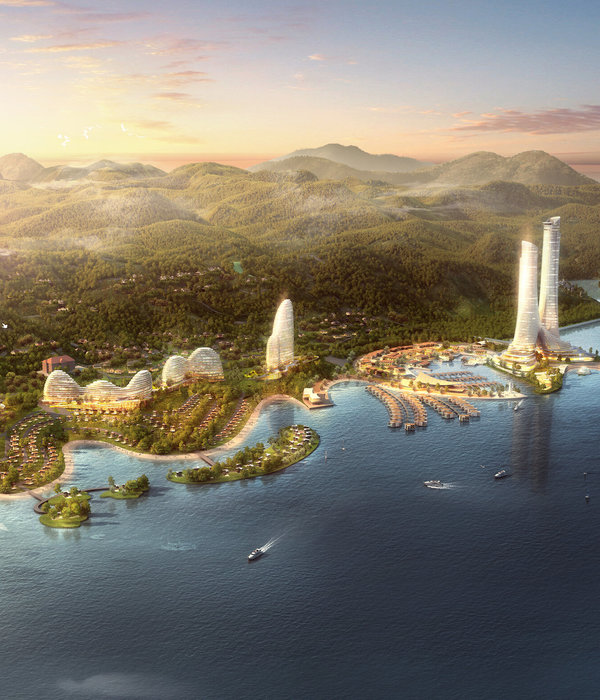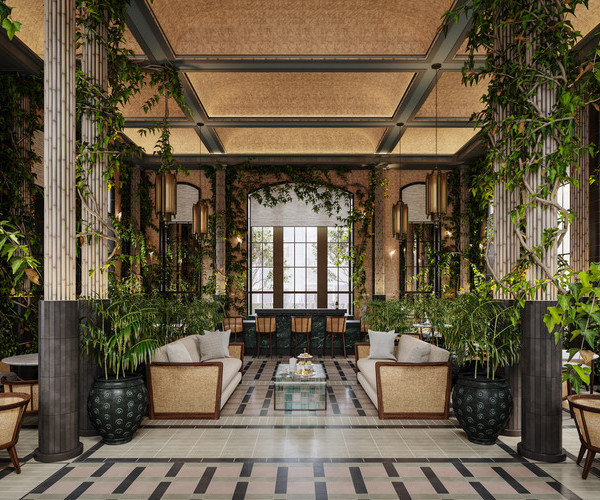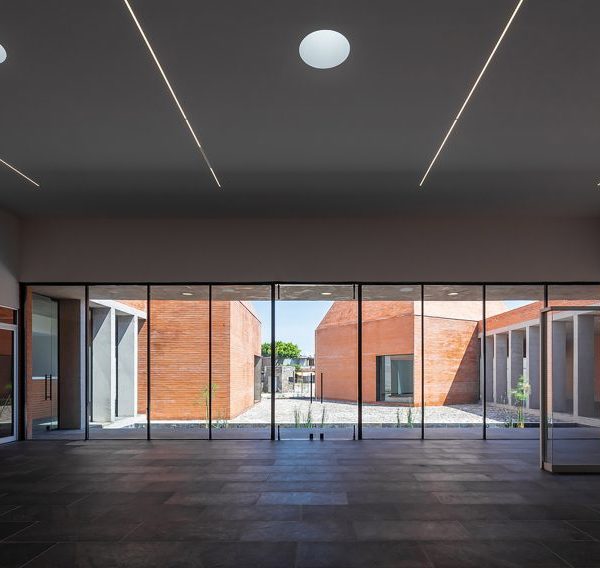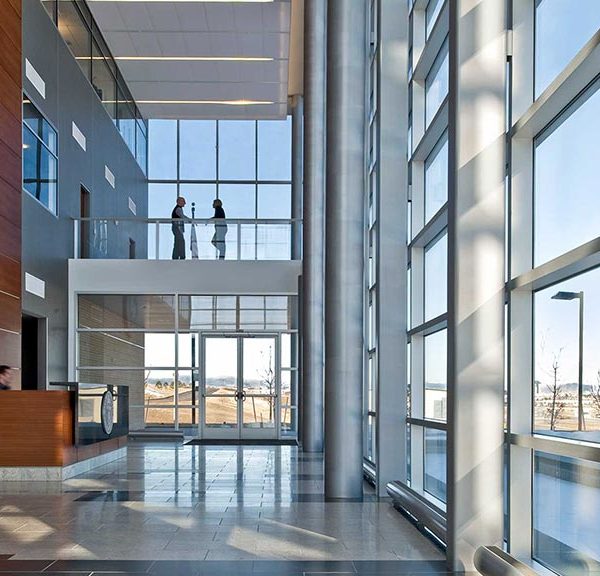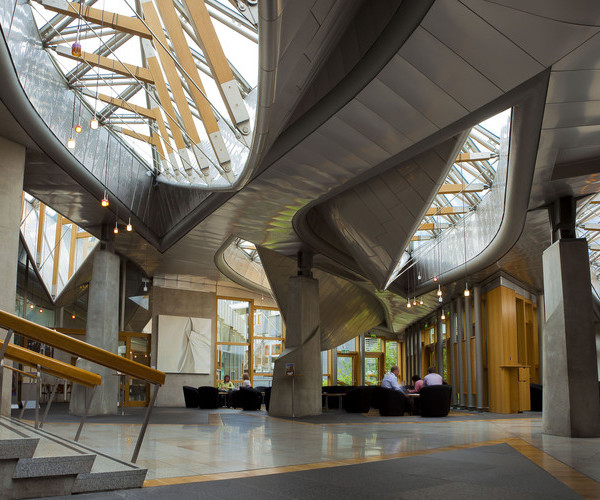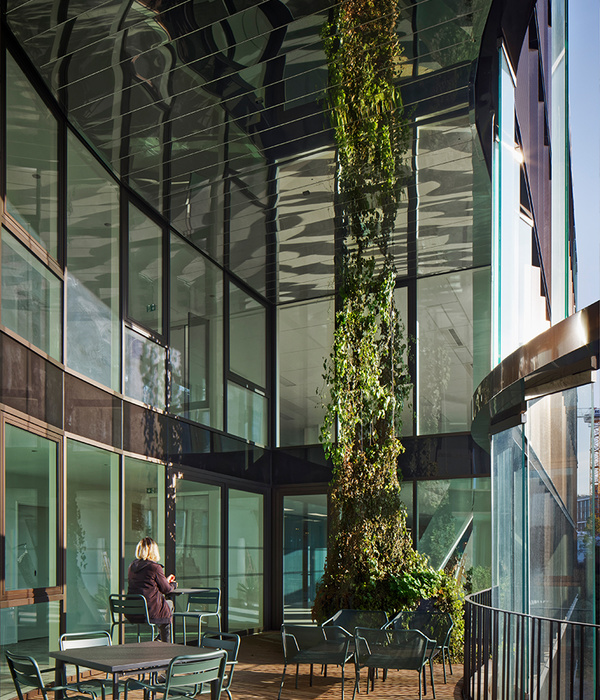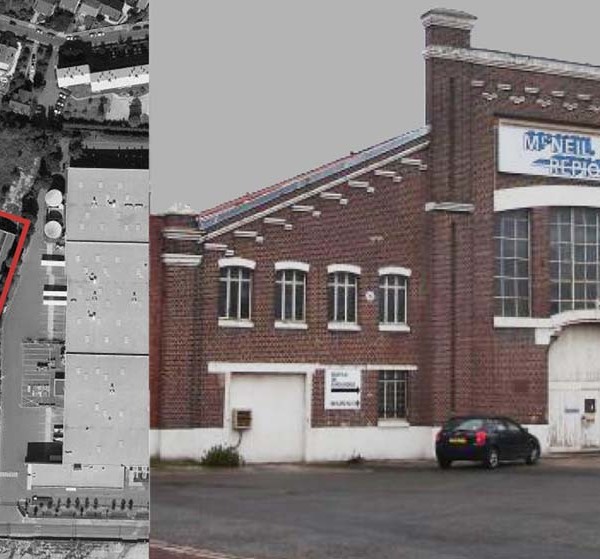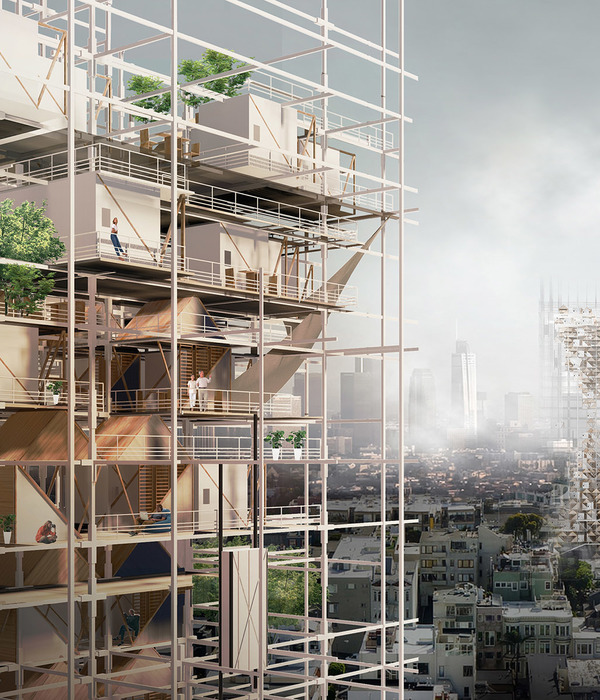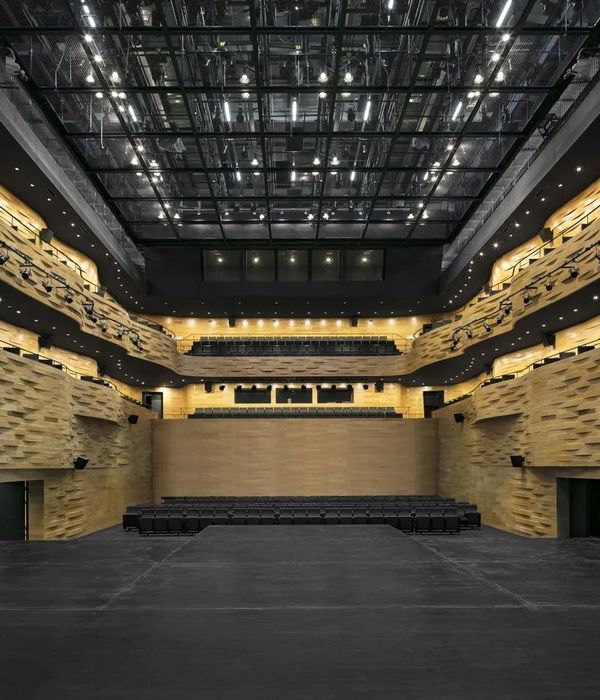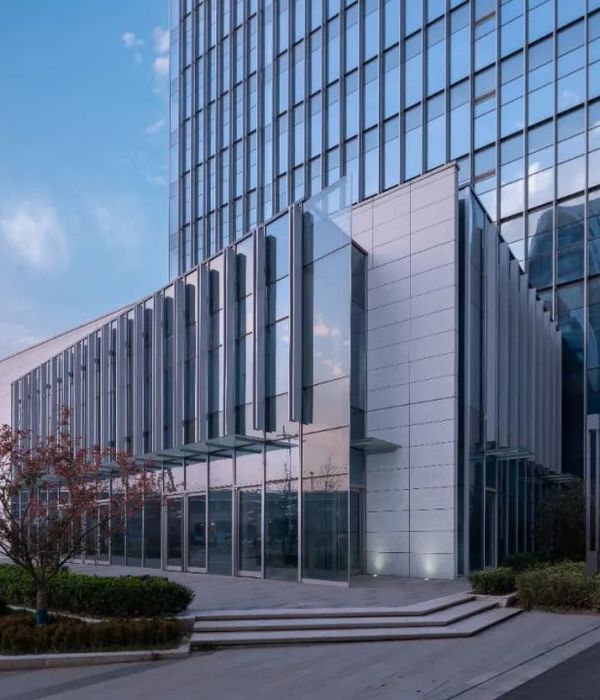Max House是Max Group of Companies旗下的优质房地产部门Max Estates开发的企业园区。项目坐落于新德里Okhla工业区,项目全部落成后将为这座绿树成荫的工业园增添两栋全新的共享办公建筑。两座新塔楼的设计旨在为当地提供充足的办公空间,此外,设计团队还将场地内现有的建筑改造为社区中心,并将其完美融入场地总体规划中,与新建塔楼形成和谐的关系。
Max House is a corporate campus developed by Max Estates, the premium real estate arm of the Max Group of Companies. Located in New Delhi’s Okhla industrial area, the development comprises two multi-tenant buildings placed within a verdant campus—two new towers designed to accommodate a myriad of workspaces and an existing building to be adapted into a community hub that integrates the ground plane of the towers.
▼项目概览,overall of the project
由Max Estates开发的MaxHouse办公大楼,强调并回应了当地对于多层办公楼的需求,它将融入景观、与环境相呼应,同时以经典而永恒的建筑形象成为同类型建筑的标杆。
业主希望建筑能够呼应Max集团的品牌文化,秉承根植于可持续性、弹性和环境和谐的基本设计理念。
建筑与室内的设计与材料表达都将反映出业主以及建筑师对于环境的责任感,同时将最先进的工作空间与高性能系统相结合。
▼分析图,analysis diagram
Max Estates’ project brief succinctly underscored the need for a multi-storey office building that would ease into the landscape and nod to its context while aiming to set a benchmark for timeless architecture. The client expressed a desire for the building to echo the brand’s underlying design philosophy rooted in sustainability, resilience, and environmental harmony. The building was to be designed in a way that its architecture and interior expression would reflect responsible sourcing and use of materials and unite it with state-of-the-art workspaces and high-performance systems.
▼项目与轻轨高架桥鸟瞰,aerial view of the projectand rail viaduct
▼项目与铁路鸟瞰,aerial view of the projectand railway
▼由巴哈伊灵曦堂看办公楼,aerial view of the projectand Baha’iHouseofWorship
项目所在场地毗邻一条熙熙攘攘的大道,场地对面则是东西走向的高架轻轨,此外,场地距离巴哈伊灵曦堂 (Baha’iHouseofWorship)以及莫迪面粉厂等老牌工业建筑仅一步之遥,其中巴哈伊灵曦堂还是当地代表性的地标建筑和旅游景点。独特的周边环境与场地条件成为本项目总体设计的灵感来源与依据。
The site adjoins a bustling thoroughfare, sitting across from an east-west metro corridor, and is a stone’s throw from old industrial buildings such as the Modi Flour Mills and the Baha’i House of Worship, an iconic landmark and tourist attraction. This presented an opportunity for the studio to determine the development’s overall design vocabulary.
▼项目鸟瞰,aerial view of the project
由于本项目靠近亚穆纳洪泛区,常年的高水位意味着该地区的土壤条件不允许基地的深度挖掘。然而,根据场地周边的交通影响分析,本项目需要设置2到3个地下车辆停车场才能满足需求,因此这一现实的矛盾给设计团队造成了不同寻常的挑战。为了满足共八层的A座办公楼的停车需求,建筑师设计了一个停车平台,同时在底层创建出一座宽敞的三层通高接待大厅。这种设计手法同时也优化了办公楼内的视野,将建筑侧翼繁茂的绿色景观引入接待大厅,同时,从二楼开始的露台层也因此享有了巴哈伊教堂和远处天际线的全景视野。此外,沿建筑西北方向的平台高度与相邻的铁路用地上的建筑高度大致相同,从而最大化了建筑西北方向的视野。
▼轴测分析图,axonometric drawing
Since the development is in proximity to the Yamuna floodplain, the high water table meant that soil conditions in the area would prove to be unfavourable for deep excavations. Additionally, traffic impact analyses necessitated the need for a two to three-basement deep vehicular Parking, thus posing an unusual challenge for the design team. To account for vehicular Parking for the eight-storey Block A that was to come up on the site, a Parking podium was devised that simultaneously opens up volume for the creation of a spacious triple-height reception lobby at the ground level. The resultant intervention also optimizes vistas — while the reception lobby offers occupants views of lush vegetation flanking the building, the terrace level from the first floor and onwards afford virtually unimpeded views of the Baha’i House of Worship, and the skyline beyond. Moreover, the podium has so been configured, along the building’s northwest, that its height is roughly the same as that of the adjacent railway colony, thereby maximizing views along this part of the building as well.
项目外观,exterior view of the project
▼园区主入口,entrance of the site
设计旨在于建筑的地面层设置一条宽阔的入库坡道方便车辆直接进入地下停车场,而场地周边则被预留给行人通道。实现人车分流的干预策略主要有两点:一是后退场地边界,将空间割让给城市和邻近的交通;二是采用绿色景观来软化场地的边界,使综合体与其周围环境之间形成更加紧密的空间与视觉联系。这种干预手段使建筑的前方形成了宽敞且极富渗透性的广场,使Max House超脱于典型的封闭式商业空间,与周围环境融为一体。
The buildings are planned to create a wide promenade on the ground level, to facilitate vehicular access up to the building line. The site periphery, in turn, has been reserved for pedestrian access. This access has been transformed through two primary interventions — the setting back of the site boundary to cede space to the city and the neighbouring traffic, and the softening of the site boundaries through landscaping to enable greater physical and visual connection between the complex and its immediate context. Through the formation of this expansive, almost porous forecourt, Max House integrates itself with its surroundings, a marked departure from typical gated commercial developments.
▼高耸的塔楼,the narrow tower
▼标志性的砖材立面,iconic brick facade
Max House独特的设计语言将其与周围的建筑区别开来,同时又使自身牢牢地嵌入到当地工业环境中,成为附近老莫迪面粉厂的当代工作空间诠释。塔楼的立面参考了面粉厂大楼,砖材与玻璃交替的立面节奏,辅以穿插其间的悬臂拱板、深置阳台以及社区露台,共同组成了本项目独特的设计语言。虽然底层空间主要为停车平台,但是底层屋顶却设有延伸的露台,能够为大楼的使用者提供额外的高架公园空间。
Distinguishing itself from its neighbours while remaining firmly embedded in its industrial context, the design vocabulary of Max House extends the narrative set by the old Modi Flour Mills in the vicinity and adapts it for a contemporary workspace. The tower’s façade references the Flour Mills building through its distinctive bands of alternating brick and glass, punctuated by spandrel panels, deep-set balconies and community terraces. While the ground floor is primarily allocated for the podium Parking spaces, the first floor features extended terraces, doubling as an elevated park for the users.
▼二层室外平台鸟瞰,aerial view of the podium level
▼二层室外平台,podium level
▼底层外廊与花园,veranda and landscape
塔楼的标准层高为3.75米,楼板的布局以及模块化的建筑立面保证了最佳的自然采光,从外部看建筑也不会产生眩光,避免了白天大楼内部对人工照明的依赖。电梯和服务核心位于建筑的两端,进而创造出开放的矩形平面,最大程度上满足了使用者对空间灵活性的需求。平面布局结合立面60:40的低墙窗比以及外部遮阳,在减少太阳眩光的同时,显著提升了建筑的被动节能性能,使本项目成为新时代办公建筑设计的范本。大楼的屋顶容纳了充足活动空间以及一家露天餐厅,为使用者创造出广阔的周边全景视野。
The tower features a floor-to-ceiling height of 3.75 metres.
The floor plates and the modulating façade have been designed to ensure optimal daylight penetration without concurrent glare, almost eliminating the dependence on artificial means of lighting in the day.
The lift and service cores are positioned along the two ends of the buildings, creating an open, rectangular floor plate that allows for maximum flexibility in terms of use.
The floor plate configuration, in conjunction with the facade’s significantly low wall-to-window ratio of 60:40 and shading spandrels to cut down solar glare, significantly elevate the passive design parameters of the building, a unique proposition in new-age office building design.
The rooftop is designed to accommodate an event space and al fresco dining while providing visitors panoramic vistas of the surrounding landscape.
▼建筑立面细部,details of the facade
▼外廊露台,outer porch terrace
设计将裸露的砖墙语言延伸到室内,为空间注入自然的“手工”吸引力。在三层通高的大堂内部,砖材与玻璃砖营造出复古别致的风格,石材以及饰面的中性色调为空间赋予了低调的优雅。与ROHA合作的区域景观设计旨在利用现有资源,即利用原生植被和水景缓解热岛效应。生态措施包括采用高效的雨水管理网络以及雨水收集系统,如:生物湿地、渗透沟、雨水花园、生物滞留区,以及在硬质景观铺地区域设置开放式的网格地面等。
The design scheme extends the expression of exposed brickwork into the interiors, injecting spaces with a natural, ’handcrafted’ appeal. While brickwork and glass blocks create the retro chic approach to the interiors of the triple-height lobby, neutral tones of stone and veneer imbue the surfaces with understated elegance. A collaboration with ROHA for the precinct’s landscape design aimed to harness existing resources, i.e. native vegetation and water, and mitigate the heat island effect. The interventions include an efficient stormwater management network as well as on-site water rainwater management treatments such as the integration of bioswales, infiltration trenches, rain gardens, bioretention areas, and open grid pavers in hardscaped areas.
接待大厅,lobby
▼咖啡厅,cafe
围护结构的设计采用了双管齐下的策略来调节建筑对于热量的吸收。外立面由空心砖砌体、绝缘拱肩板和双层玻璃单元组成,这种墙体具有良好的热性能,能够显著降低建筑的运营成本。狭长的建筑体量则能够确保平面75%的部分都能获得良好的自然采光。露台阳台等室外空间为室内办公空间引入了新鲜空气循环,其空气流通率比美国采暖、制冷和空调工程师协会(ASHRAE)标准62.1-2010所要求的最低率高出至少30%。此外,塔楼的屋顶上还设置了多达82块的高太阳反射指数(SRI)瓦片,以最大限度地减少建筑对当地区域气候的影响,同时减少建筑体量的热量吸收与损失。
The building envelope is designed using a two-pronged strategy to regulate the ingress of heat. The façade is composed of hollow brick masonry, insulated spandrel panels, and double-glazed glass units, significantly lowering operating costs. The narrow floor plates ensure that over seventy-five per cent of the occupied floor area receives optimal daylight across all building floors. Spill-out areas facilitate fresh air circulation to occupied spaces by at least thirty per cent above the minimum rates required by the American Society of Heating, Refrigerating and Air-Conditioning Engineers (ASHRAE) Standard 62.1-2010. As many as eighty-two high solar reflective index (SRI) tiles will be installed on the roof to minimize the impact on the micro-climate and reduce heat gain and loss through the built volume.
接待前台,reception desk
▼入口闸机,entrance gate machine
通过整合被动式设计策略、采用可再生和低影响材料和技术,优化能源和水的消耗,本项目建筑获得了LEED金牌认证。Max House标志着德里商业区如雨后春笋般涌现的玻璃大厦海洋正在经历明显的转变。在这个转变的过程中,本项目致力于为印度商业建筑树立一个可持续发展的优秀范本。
Through the integration of passive design principles, use of renewable and low impact materials and technology to optimise both energy and water consumption, the building has received a LEED GOLD certification. Max House marks a pronounced shift from the sea of soulless glass towers sprouting across Delhi’s business districts. In doing so, the project attempts to create an alternative benchmark for commercial architecture in the Indian context.
▼办公空间,office area
▼办公空间享有理想景观视野,the office space enjoys ideal view
▼总平面图,site plan
▼地下层平面图,basement plan
▼底层平面图,stilt floor plan
二层平面图,podium level 2 plan
▼办公标准层平面图,typical office floor plan
五层平面图,5th floor plan
▼剖面图,section
▼外墙与结构细部,wall sections & details
Project Information Sheet
Typology: Commercial (Multi-Tenanted Building)Name of Project: Max House
Location: Okhla, New Delhi
Name of Client: Mr. Analjit Singh
Name of Client’s Firm: Max Estates
Address: Max House, 1, Dr Jha Marg, Okhla Phase III, Okhla, New Delhi, Delhi 110020
Tel No:+91-9910338630
Email: anil.malhotra@maxestates.in
Design Firm: Studio Lotus
Design Team: Sidhartha Talwar, Ambrish Arora, Rana Shil, Subrata Ray
Site Area:33,272 sq.ft.
Built-Up Area: 1.4 lakh sq.ft.
Start Date: 4th October 2017
Completion Date: August 2021
Photographer: Noughts & Crosses LLP
Project Fact File: Max House, New Delhi
PRODUCTS / VENDORS
ACP / Glass / Concrete Glass – Saint Gobain; Concrete – RMC India
Sanitaryware / Fittings Duravit
Flooring Stone – Stonex; Tile – Dream Home
Furniture: Mangrove Collective
Air Conditioning: Febo Engineering
BMS: Siemens
Lighting: Vijay Technical Services & Construction Pvt Ltd
Paint: Asian Paints
CONSULTANTS
Structural NNC Design International
Mechanical Abid Hussain Consultant
Electrical Abid Hussain Consultant
Landscape Roha Landscape Architecture & Planning
HVAC Abid Hussain Consultant
Plumbing Abid Hussain Consultant
Lighting : Lirio Lopez
CONTRACTORS
Interiors: Suri Construction Company
Structural : Suri Construction Company
Mechanical: Febo engineering
Electrical: Vijay Technical Services & Construction Pvt Ltd
Civil: Suri Construction Company
HVAC: Febo Engineering Pvt Ltd
Plumbing: DD Pradhan
Façade: Pranav Door & Window Pvt Ltd
{{item.text_origin}}

